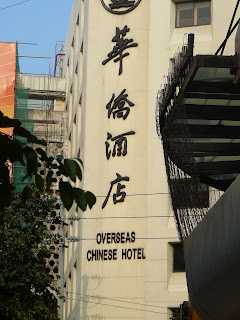 I finally tracked down the Botanic Gardens & since I was feeling a mite cooped up (winter) I decided to go in spite of the fact that it looked like it might rain at any time. Naturally it started to rain about half way there.
I finally tracked down the Botanic Gardens & since I was feeling a mite cooped up (winter) I decided to go in spite of the fact that it looked like it might rain at any time. Naturally it started to rain about half way there.I thought when I looked at the map that it would be semi-rural but I didn't take into consideration the impact of a population of 17 million people. At least from the road, there is no evidence whatsoever of rurality. It's possible that the factories/shops/flats don't extend particularly far back from the road; but I think it's more likely that my map is out of date.
I'm a bit curious though becasue Guangzhou is actually surronded by mountains. I think I may have mentioned (about the second week that I was here) that I had been to a place called "Five Mountains" and there weren't any. It turned out today that that was unfair. The place is called "Fifth Mountain" and as we drove through it it was noticably higher than Tian He (where I live).


(Place names are tricky. There is an island called "Second Sand Island" - I spent months trying to find the "First Sand Island". Naturally there isn't one, but I discovered that "Big Sandy Headland" was in fact once an island until the civil engineers go to it and attached it back to the mainland.)
Camellia garden
In fact, while trying to get out of the gardens at 5:29 - they don't give you a map - I found a sign that said "Fire Stove Mountain" (to give a literal translation) which suggests that spending more time in and around the Botanic Gardens could lead me to the Guangzhou wilderness. With a name like that, I feel a spot of vulcanology coming on. Mind you, I have a nasty feeling vulcanology is the science of rubber. Still, you can take a punt on the idea.
The gardens are huge. I did see a sign that said how many hectares it was but that kind of thing never means much to me. I prefer the "There is no way in the world you could walk around this in a day and see more than 30% of it without proceeding at forced march pace" measurement. Or you could go with the fact that they do a busy bike & golf cart rental business in summer.
It's either because I am vaguely English, or possibly from Melbourne, but I quite like walking outdoors in winter. It was raining, but it was a curious kind of rain that seemed to be more like rain than drizzzle, but leave you much less wet than a drizzle would. So even though I was without an unbrella (because I am a goose) aprt from a brief period where I felt obliged to take shelter in the conservatory (left) I was quite happy to walk around in the rain. If I come down with pneumonia tomorrow, I guess it will have been not such a good idea.
Note that there is just as much mist inside the conservatory as there was outside. The information board at the front gate says that the gardens have been operating since 1954, but there is a huge amount of work going on. Most of everything looks substantially new - less then 3 years old, given how fast things age here.
The plant pictures are delayed by technological considerations. I can't really comment on the plantisng except to say that they have a lot of stuff. And the plantings are quite seriously massed for the most part, which is sort of good I think. It gives a bit of a feeling for how things might look indigenously, although, to be fair, massed cacti is probably more a statement by a landscape gardener than an actual recreation of an arid plantscape.
Another interesting feature of the place is that there is some seriousl archaeological work going on. Once again, there has been a great attempt to combine archaeology with public viewing but unfortunately the viewing pits were suffering from chronic condensation and poor drainage. So I didn't see very much and unless it's rock we're supposed to be looking at, I don't think anybody will be seeing very much in the future. Preservation is a tricky business.
I may have mentioned elsewhere that there is a bit of southern pride motivating the presentation of the archaeology - elsewhere there is the Nan Yue "emperor" / "jumped up garrison commander" debate; but in a way, anything that gets history public is OK (until we move into history as an excuse for invading the wherever).


Let's be blunt though - this is a little overstated. It's interesting that the bas-relief has outlasted the Stalinist architects who introduced it to China; until the 1940's it was not at all a Chinese thing. It seems now to pay much more attention to the reality of Asian faces than the Russian version (now it's the high end women's fashion industry that seems unaware that it's in Asia). It's just, perhaps, that the nutritional inputs of a Neolithic fishing village (I know we're on the slopes of a mountain now, but it was a fishing village then) seem to me unlikely to support such muscular physical development.














































